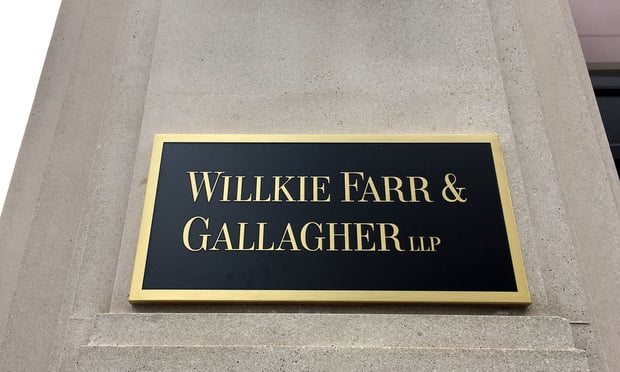After Bribery Bust, Willkie Is Latest Firm to Face Vacuum in Leadership
What does Gordon Caplan's ouster mean for management of the Wall Street firm? And what are the lessons for other firms facing a sudden shakeup at the top?
March 14, 2019 at 05:00 PM
4 minute read
 Photo: Diego M. Radzinschi/ALM
Photo: Diego M. Radzinschi/ALM
No law firm wants to find itself with a sudden gap in its leadership, as Willkie Farr & Gallagher did this week.
But the news that Gordon Caplan was placed on leave from the firm—following a federal indictment alleging that he paid $75,000 to have his daughter's college test score fixed—is one more reminder of the singular nature of firms, where lofty titles carry different weight at different shops. In the end, the long-term effect of any disruption on the Wall Street firm could be muted.
Caplan, a top dealmaker at Willkie, joined the firm's executive committee and became co-chairman in February 2016. But his position was secondary to the firm's two chairmen, Thomas Cerabino and Steven Gartner, who have been leading the firm since the start of 2010, following 21 months as vice co-chairmen.
 Gordon Caplan. (Photo: Carmen Natale/ALM)
Gordon Caplan. (Photo: Carmen Natale/ALM)In a November 2016 interview with Forbes, after Caplan took on the co-chair title, Cerabino explained that he and Gartner lead the firm's 10-member executive committee and that “ultimately” the two are “responsible for directing the firm.” In recent years, it's Gartner who has served as the public voice of the firm.
“The role and responsibility of different types of leader varies very much between different firms,” said Zeughauser Group consultant Kent Zimmermann.
The firm declined to comment about the nature of Caplan's leadership role. But at most firms with co-leaders, there's a formal division of responsibilities, at least internally, noted Altman Weil's Eric Seeger.
“People need to know who to go to for what,” he said.
The immediate move for the firm is likely to apportion out Caplan's management responsibilities to another leader while it grapples with the current and potential headaches of having a prominent partner publicly disgraced and facing severe legal jeopardy.
But the very fact that Caplan was one of several names attached to the management of the firm suggests that his exit will not be as significant as 2018's most stunning law firm leadership change: the abrupt resignation of Latham & Watkins' sole chairman, Bill Voge, after his “communications of a sexual nature” with a woman who had no connection to the firm were revealed.
There, vice chairs Ora Fisher and Richard Trobman immediately stepped in as interim co-chairs, and Trobman was selected as the new chair and managing partner three months later. The disruption has had no apparent drag on Latham's performance. In 2018, the firm had its strongest financial performance in nearly a half-decade.
“It would be infrequent that the absence of one person for a period of time would be a game changer,” Zimmermann contended.
Of course, it doesn't require a scandal to unseat a leader without warning. Consider recent cases such as Dane Butswinkas' short-lived move to Tesla from Williams & Connolly, or the leave that Baker McKenzie global chairman Paul Rawlinson is currently taking for “exhaustion.” Whatever the nature of Caplan's alleged crime or his management role, his unexpected exit serves as another example of the need for robust succession planning.
“It's always wise to create a leadership pipeline by putting your likely future leaders in practice leadership seats and committee chairs and as project leaders,” Seeger said. “That's a good way to assess leadership capacity and groom people for potential management committee and potential management partner positions.”
And beyond simply identifying future leaders, it's good to know who will step in in the event of any sort of rupture. Ironically, Willkie might have a leg up on this sort of contingency planning, thanks to a recent management decision.
In January, the firm hired Michael Gottlieb, a former associate White House counsel under President Barack Obama, from Boies Schiller Flexner. His brief? To lead a new crisis management practice at the firm.
Read More
On Leave From Willkie, Where Does Gordon Caplan Go From Here?
Latham Had 'No Choice' but to Remove Voge, Industry Watchers Say
This content has been archived. It is available through our partners, LexisNexis® and Bloomberg Law.
To view this content, please continue to their sites.
Not a Lexis Subscriber?
Subscribe Now
Not a Bloomberg Law Subscriber?
Subscribe Now
NOT FOR REPRINT
© 2025 ALM Global, LLC, All Rights Reserved. Request academic re-use from www.copyright.com. All other uses, submit a request to [email protected]. For more information visit Asset & Logo Licensing.
You Might Like
View All
Law Firms Expand Scope of Immigration Expertise Amid Blitz of Trump Orders
6 minute read

Trending Stories
- 1Uber Files RICO Suit Against Plaintiff-Side Firms Alleging Fraudulent Injury Claims
- 2The Law Firm Disrupted: Scrutinizing the Elephant More Than the Mouse
- 3Inherent Diminished Value Damages Unavailable to 3rd-Party Claimants, Court Says
- 4Pa. Defense Firm Sued by Client Over Ex-Eagles Player's $43.5M Med Mal Win
- 5Losses Mount at Morris Manning, but Departing Ex-Chair Stays Bullish About His Old Firm's Future
Who Got The Work
J. Brugh Lower of Gibbons has entered an appearance for industrial equipment supplier Devco Corporation in a pending trademark infringement lawsuit. The suit, accusing the defendant of selling knock-off Graco products, was filed Dec. 18 in New Jersey District Court by Rivkin Radler on behalf of Graco Inc. and Graco Minnesota. The case, assigned to U.S. District Judge Zahid N. Quraishi, is 3:24-cv-11294, Graco Inc. et al v. Devco Corporation.
Who Got The Work
Rebecca Maller-Stein and Kent A. Yalowitz of Arnold & Porter Kaye Scholer have entered their appearances for Hanaco Venture Capital and its executives, Lior Prosor and David Frankel, in a pending securities lawsuit. The action, filed on Dec. 24 in New York Southern District Court by Zell, Aron & Co. on behalf of Goldeneye Advisors, accuses the defendants of negligently and fraudulently managing the plaintiff's $1 million investment. The case, assigned to U.S. District Judge Vernon S. Broderick, is 1:24-cv-09918, Goldeneye Advisors, LLC v. Hanaco Venture Capital, Ltd. et al.
Who Got The Work
Attorneys from A&O Shearman has stepped in as defense counsel for Toronto-Dominion Bank and other defendants in a pending securities class action. The suit, filed Dec. 11 in New York Southern District Court by Bleichmar Fonti & Auld, accuses the defendants of concealing the bank's 'pervasive' deficiencies in regards to its compliance with the Bank Secrecy Act and the quality of its anti-money laundering controls. The case, assigned to U.S. District Judge Arun Subramanian, is 1:24-cv-09445, Gonzalez v. The Toronto-Dominion Bank et al.
Who Got The Work
Crown Castle International, a Pennsylvania company providing shared communications infrastructure, has turned to Luke D. Wolf of Gordon Rees Scully Mansukhani to fend off a pending breach-of-contract lawsuit. The court action, filed Nov. 25 in Michigan Eastern District Court by Hooper Hathaway PC on behalf of The Town Residences LLC, accuses Crown Castle of failing to transfer approximately $30,000 in utility payments from T-Mobile in breach of a roof-top lease and assignment agreement. The case, assigned to U.S. District Judge Susan K. Declercq, is 2:24-cv-13131, The Town Residences LLC v. T-Mobile US, Inc. et al.
Who Got The Work
Wilfred P. Coronato and Daniel M. Schwartz of McCarter & English have stepped in as defense counsel to Electrolux Home Products Inc. in a pending product liability lawsuit. The court action, filed Nov. 26 in New York Eastern District Court by Poulos Lopiccolo PC and Nagel Rice LLP on behalf of David Stern, alleges that the defendant's refrigerators’ drawers and shelving repeatedly break and fall apart within months after purchase. The case, assigned to U.S. District Judge Joan M. Azrack, is 2:24-cv-08204, Stern v. Electrolux Home Products, Inc.
Featured Firms
Law Offices of Gary Martin Hays & Associates, P.C.
(470) 294-1674
Law Offices of Mark E. Salomone
(857) 444-6468
Smith & Hassler
(713) 739-1250











